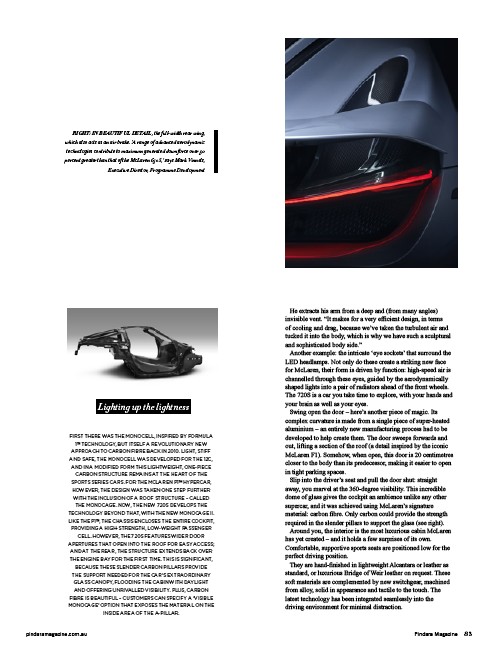
He extracts his arm from a deep and (from many angles)
invisible vent. “It makes for a very efficient design, in terms
of cooling and drag, because we’ve taken the turbulent air and
tucked it into the body, which is why we have such a sculptural
and sophisticated body side.”
Another example: the intricate ‘eye sockets’ that surround the
LED headlamps. Not only do these create a striking new face
for McLaren, their form is driven by function: high-speed air is
channelled through these eyes, guided by the aerodynamically
shaped lights into a pair of radiators ahead of the front wheels.
The 720S is a car you take time to explore, with your hands and
your brain as well as your eyes.
Swing open the door – here’s another piece of magic. Its
complex curvature is made from a single piece of super-heated
aluminium – an entirely new manufacturing process had to be
developed to help create them. The door sweeps forwards and
out, lifting a section of the roof (a detail inspired by the iconic
McLaren F1). Somehow, when open, this door is 20 centimetres
closer to the body than its predecessor, making it easier to open
in tight parking spaces.
Slip into the driver’s seat and pull the door shut: straight
away, you marvel at the 360-degree visibility. This incredible
dome of glass gives the cockpit an ambience unlike any other
supercar, and it was achieved using McLaren’s signature
material: carbon fibre. Only carbon could provide the strength
required in the slender pillars to support the glass (see right).
Around you, the interior is the most luxurious cabin McLaren
has yet created – and it holds a few surprises of its own.
Comfortable, supportive sports seats are positioned low for the
perfect driving position.
They are hand-finished in lightweight Alcantara or leather as
standard, or luxurious Bridge of Weir leather on request. These
soft materials are complemented by new switchgear, machined
from alloy, solid in appearance and tactile to the touch. The
latest technology has been integrated seamlessly into the
driving environment for minimal distraction.
RIGHT: IN BEAUTIFUL DETAIL, the full-width rear wing,
which also acts as an air brake. ‘A range of advanced aerodynamic
technologies contribute to maximum generated downforce over 50
percent greater than that of the McLaren 650S,’ says Mark Vinnels,
Executive Director, Programme Development
Lighting up the lightness
FIRST THERE WAS THE MONOCELL, INSPIRED BY FORMULA
1™ TECHNOLOGY, BUT ITSELF A REVOLUTIONARY NEW
APPROACH TO CARBON FIBRE BACK IN 2010. LIGHT, STIFF
AND SAFE, THE MONOCELL WAS DEVELOPED FOR THE 12C,
AND IN A MODIFIED FORM THIS LIGHTWEIGHT, ONE-PIECE
CARBON STRUCTURE REMAINS AT THE HEART OF THE
SPORTS SERIES CARS. FOR THE MCLAREN P1™ HYPERCAR,
HOWEVER, THE DESIGN WAS TAKEN ONE STEP FURTHER
WITH THE INCLUSION OF A ROOF STRUCTURE – CALLED
THE MONOCAGE. NOW, THE NEW 720S DEVELOPS THE
TECHNOLOGY BEYOND THAT, WITH THE NEW MONOCAGE II.
LIKE THE P1™, THE CHASSIS ENCLOSES THE ENTIRE COCKPIT,
PROVIDING A HIGH-STRENGTH, LOW-WEIGHT PASSENGER
CELL. HOWEVER, THE 720S FEATURES WIDER DOOR
APERTURES THAT OPEN INTO THE ROOF FOR EASY ACCESS;
AND AT THE REAR, THE STRUCTURE EXTENDS BACK OVER
THE ENGINE BAY FOR THE FIRST TIME. THIS IS SIGNIFICANT,
BECAUSE THESE SLENDER CARBON PILLARS PROVIDE
THE SUPPORT NEEDED FOR THE CAR’S EXTRAORDINARY
GLASS CANOPY, FLOODING THE CABIN WITH DAYLIGHT
AND OFFERING UNRIVALLED VISIBILITY. PLUS, CARBON
FIBRE IS BEAUTIFUL – CUSTOMERS CAN SPECIFY A ‘VISIBLE
MONOCAGE’ OPTION THAT EXPOSES THE MATERIAL ON THE
INSIDE AREA OF THE A-PILLAR.
pindaramagazine.com.au Pindara Magazine 83